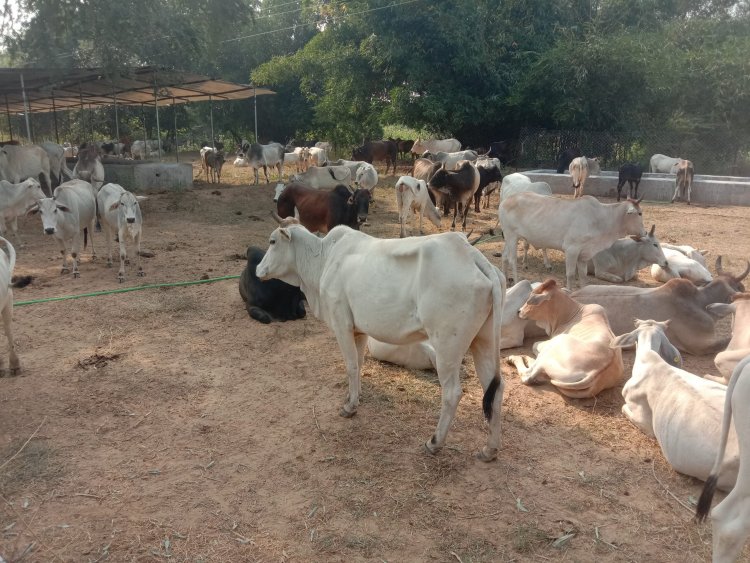A NITI Aayog panel has suggested that gaushalas should be helped through capital assistance and marketing of cow dung and cow urine-based formulations for application in agriculture to make them economically viable. Besides, the task force, headed by NITI Aayog Member Ramesh Chand, has proposed setting up a portal for online registration of all gaushalas.
The report titled 'Production and Promotion of Organic and Bio Fertilisers with Special Focus on Improving Economic Viability of Gaushalas' says that gaushalas should be liberally financed for making a capital investment and working expenses at concessional rates of interest. "Interested gaushalas should be helped through capital assistance and marketing of cow dung and cow urine-based formulations for application in agriculture. "This will require some viability gap funding," the report said.
According to the report, a portal like the Darpan portal of NITI Aayog should be created for online registration of all gaushalas, which will then be eligible to get support from the animal welfare board. To address the issue of the menace caused by increasing numbers of stray cattle in urban and rural areas, the report said, "All grants to gaushalas should be linked to the number of cows, and more emphasis should be on dry, recused or abandoned cattle.
Specific policy measures and support are required to encourage the commercial production, packaging, marketing and distribution of cow dung-based organic fertilisers, including brand development, it said. Further, the report said, efforts should be made to attract private investments in mass-scale production of organic and bio-fertiliser, bio-pesticides, soil-enriching products and stimulants for use in agriculture, and various types of formulations for use in households.
NITI Aayog at the request of the task force got a study done by the National Council of Applied Economic Research (NCAER) to prepare technical parameters and estimates of investments and benefits and costs of possible economic activities by gaushalas. According to the Bureau of Indian Standards, a gaushala is a protective shelter, abode, or sanctuary for cows, set up to improve their health and life, sell pure milk and cow products, conserve germplasm, and stop animal cruelty.
Read This Also: Animpet Ecomm startup starts online trade platform for products in animal sector
Noting that cow dung is the major produce of gaushala, the report said it faces several challenges in realising its economic value. "Gaushalas should be helped through capacity development and other means to generate income from gobar," the report said, adding that this should include proper processing of gobar using biogas plants, value addition, marketing and certification of the cow dung-based organic as well as bio-fertilisers.
Pointing out that heavy subsidy on inorganic fertilisers especially on urea discourages the use of organic sources of nutrients, which do not get any subsidy, it said there is a need for some parity in support for chemical fertilisers vis-a-vis organic and cow dung and cow urine-based compost, manures, jivamrit, ghanjivamrit and other organic fertiliser formulations.

The report noted that gaushalas themselves lack the capacity to market compost and other organic fertiliser produced by them and there is no organised market and buyer for their produce. "Public sector fertiliser distribution agencies like IFFCO, KRIBHCO and such state-level agencies should be mandated to market standardised organic and bio-fertiliser produced by gaushalas," it suggested.
As per the report, some gaushalas are not able to use public land provided to them by the government for Biogas/Organic fertiliser/Bioenergy etc due to conditions of land use, so provision should be made to alter the land use system for adopting various enterprise models by gaushalas even via Public-Private Partnership (PPP).
The report claimed that adding 20 per cent gobar to the biomass gives the best result. A new scheme like Sustainable Alternative towards Affordable Transportation (SATAT) and Galvanizing Organic Bio-Agro Resources (GOBARdhan) plans should be launched in the central sector under the Ministry of Agriculture and Ministry of Animal Husbandry to use agri bio-waste and cattle waste available with gaushalas to produce.
CBG and organic manure from the slurry left after producing CBG, it suggested. The report recommended that gaushalas should be included in the beneficiary list of all the central sector schemes related to dairying and animal husbandry, waste to wealth and renewable energy.
The task force team visited a few gaushalas and interacted with their management to understand the situation, operation, facilities, livestock upkeep, infrastructure and condition of gaushalas. The total cattle population in the country increased by 0.8 per cent during 2012-2019 while it decreased by about 4 per cent during 2007-12. According to the 20th livestock census, the total bovine population in India is around 30 crore, out of which around 64 per cent are cattle.
The finance minister in the Budget speech of 2020 announced that the government shall encourage the balanced use of all kinds of fertilisers, including traditional organic and other innovative fertilisers.